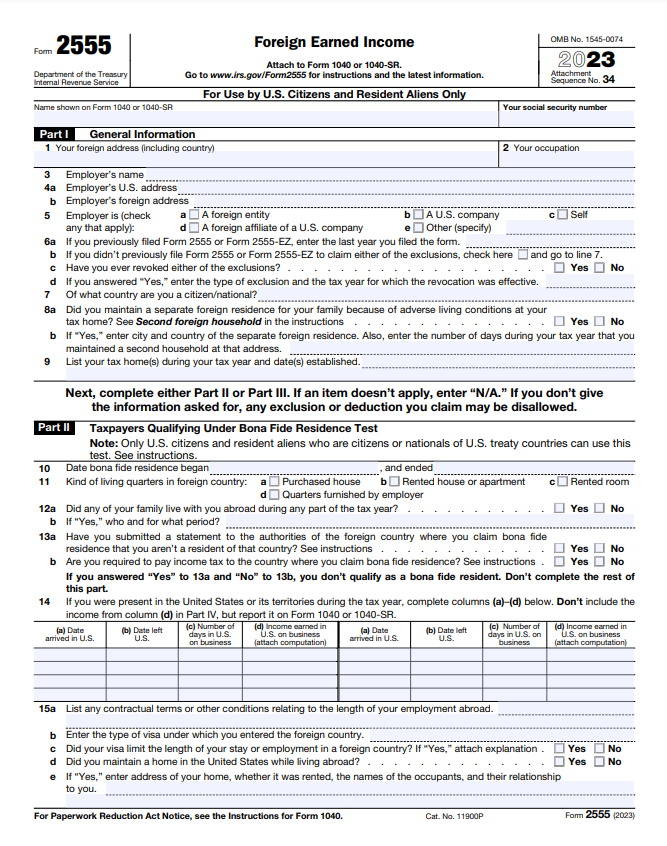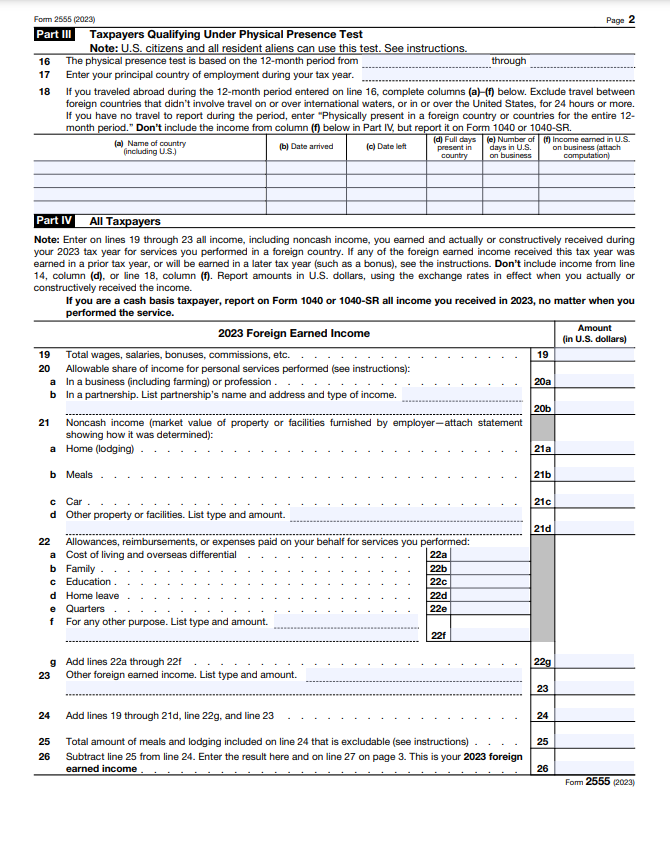Have you ever dreamt of working abroad, embracing the digital nomad lifestyle, or expanding your professional horizons globally? Are you ready to unlock the potential of substantial tax savings? Do you want to ensure that your foreign-earned income doesn’t slip through the cracks of complex tax regulations? Enter Form 2555—the key to optimizing your tax return when living and working abroad. Form 2555 isn’t just another tax form; it’s your key to unlocking a world of financial possibilities.
Walk through the intricacies of Form 2555 and explore not just instructions but a roadmap to financial empowerment. So buckle up and embark on a journey to demystify the art of filing Form 2555 and seizing every opportunity to keep more of your hard-earned money. It’s not just about compliance; it’s about strategically navigating the tax landscape and securing the financial rewards you deserve.
To unleash the potential for substantial tax benefits:
- Determine Your Eligibility
- Gather the Required Documents
- Download Form 2555
- Fill Out the Form
- Attach Supporting Documents
- Check for Exclusions
- Calculate Your Exclusion
- Complete Additional Forms
- File Your Tax Return
- Keep Copies of Your Documents
Recap
1. Determine Your Eligibility



To understand the intricacies of filing Form 2555, examine factors such as your tax home and the physical presence test, which play pivotal roles in determining your eligibility for foreign-earned income exclusion. For instance, if you’re an expatriate who spent a significant part of the tax year outside the U.S., Form 2555 becomes essential. By meeting the criteria outlined in this form, you can exclude a portion of your foreign-earned income, resulting in potential tax savings. The careful exploration of eligibility criteria ensures accurate and compliant filing, aligning your financial strategies with the tax regulations designed for U.S. citizens living and working abroad.
2. Gather the Required Documents
To ensure accurate reporting of foreign-earned income, meticulously document all your foreign income sources. For example, if you have a freelance gig based in another country or if you work for a multinational corporation, each income stream needs to be accurately reported on Form 2555. Take the time to compile detailed records of your earnings, ensuring that you account for every source of foreign income.
This documentation not only aids in accurate reporting but also serves as a valuable reference in case of any discrepancies or audit inquiries. Include invoices, payment records, and any relevant contractual agreements to substantiate your reported foreign income. By maintaining a thorough record of your earnings, you not only fulfill your reporting obligations but also establish a robust financial trail that can bolster the accuracy and legitimacy of your foreign income reporting.
3. Download Form 2555
To navigate the complexity of Form 2555, visit the official IRS website at www.irs.gov and navigate to the “Forms & Instructions” section. Utilize the search function or browse through the available forms to locate Form 2555, and ensure you select the version corresponding to the tax year you’re filing.
Download the PDF by clicking on the form’s link, and save it to a readily accessible location on your computer or device. If you’re filing electronically, consider using tax preparation software, which often includes the necessary forms. Always prioritize the official IRS website or trusted software to ensure the use of the most current and accurate form, and consult the accompanying instructions for proper completion.
>>>PRO TIPS: Form 9465: What It Is, How to File It
4. Fill Out the Form
To complete Form 2555 accurately, confirm eligibility and download the form from the official IRS website. Provide personal information, specify the qualification period, and choose the appropriate exclusion type, whether foreign earned income exclusion (FEIE) or foreign housing exclusion (FHE). Complete the income section, including details of foreign earned income, and, if applicable, address the housing exclusion portion. Calculate the exclusion amount using the provided worksheets, ensuring precise figures. Check for other eligible credits and deductions, review the form meticulously, and attach supporting documents. File the tax return, either electronically or by mail, and keep copies of all documentation for future reference. For complex situations, consider seeking advice from a tax professional specializing in foreign income matters to ensure compliance and optimize potential benefits.
5. Attach Supporting Documents
To make the process of filing Form 2555 seamless, gather all necessary documents, including your passport, travel records, and income statements. This organized approach ensures a smoother filing process, especially if you have multiple foreign income sources or varied types of income.
6. Check for Exclusions
To safeguard your financial interests when reporting foreign income, explore the various tax benefits available to you. For instance, if you’re a freelancer providing services to clients abroad, understand how the foreign-earned income exclusion can significantly impact your tax liability.
7. Calculate Your Exclusion
To avoid common pitfalls and errors in Form 2555 filing, familiarize yourself with common mistakes, such as miscalculations or missing supporting documents. For instance, failing to provide proof of your physical presence in a foreign country can lead to filing errors. Calculating your exclusion is a critical aspect that is often prone to errors. Ensure you accurately compute your foreign-earned income exclusion, considering factors like housing costs and foreign-earned income.
Common miscalculations can result in either underreporting your income, which might trigger an audit, or overreporting, leading to a potential overpayment of taxes. Take the time to understand the intricacies of the exclusion calculation, seeking guidance if needed, to avoid these pitfalls and ensure your Form 2555 filing is accurate and in compliance with IRS regulations.
>>>GET SMARTER: Form 5498-ESA: What It Is, How to File It
8. Complete Additional Forms
To empower yourself with accurate information about foreign income reporting, delve into the specifics of any supplementary forms required to accompany your Form 2555 filing. Depending on your circumstances, you might need to fill out additional forms like Schedule 1, Supplemental Income and Adjustments, or Form 1116, Foreign Tax Credit. If you’ve earned income from foreign sources and paid taxes to a foreign government, Form 1116 can be crucial in claiming credit for those foreign taxes.
Thoroughly review the IRS instructions for Form 2555, which will provide insights into any additional forms needed based on your situation. For example, if you have foreign housing expenses to claim, understanding the intricacies of Form 2555, Part VI, Housing Deduction, is essential. Always cross-reference the requirements, ensuring that you’ve completed all relevant forms accurately, to prevent processing delays and potential issues with your tax return.
9. File Your Tax Return
To secure your financial future and minimize tax burdens related to foreign income, file your tax return on time, keep copies for your records, and, if necessary, seek professional advice for complex foreign income situations. This comprehensive approach ensures compliance and optimizes your tax position.
10. Keep Copies of Your Documents
To stay in compliance with tax regulations while filing Form 2555, establish an organized system for document retention, starting with the creation of digital backups. Scan and save your completed Form 2555, along with all supporting documents, in a secure and easily accessible digital format. Consider using cloud storage services or external hard drives to safeguard your files.
Additionally, maintain physical copies of essential documents, especially those that may be challenging to replace, such as original receipts for deductible expenses. Create a dedicated folder for your foreign income documentation, subdividing it by tax year for clarity. Regularly update your file with any new information, ensuring a comprehensive record.
Recap
In conclusion, by understanding the benefits, limitations, and common pitfalls, you’re not just meeting tax obligations; you’re actively optimizing your financial standing. This isn’t merely a tax form; it’s a key to unlocking tax benefits, securing your financial future, and staying compliant with regulations. Whether you’re a digital nomad or a global professional, the steps you’ve taken empower you to control your financial destiny.
As you wrap up this tax filing process, reflect on the practical applications and real-world implications. Keep this empowerment alive beyond tax season by staying informed and maximizing your financial potential. Until the next filing season, revel in the satisfaction of financial control and the confidence that comes with it.
This post is to be used for informational purposes only and does not constitute legal, business, or tax advice. Each person should consult his or her own attorney, business advisor, or tax advisor with respect to matters referenced in this post. . For comprehensive tax, legal or financial advice, always contact a qualified professional in your area. S’witty Kiwi assumes no liability for actions taken in reliance upon the information contained herein.








No Comment! Be the first one.